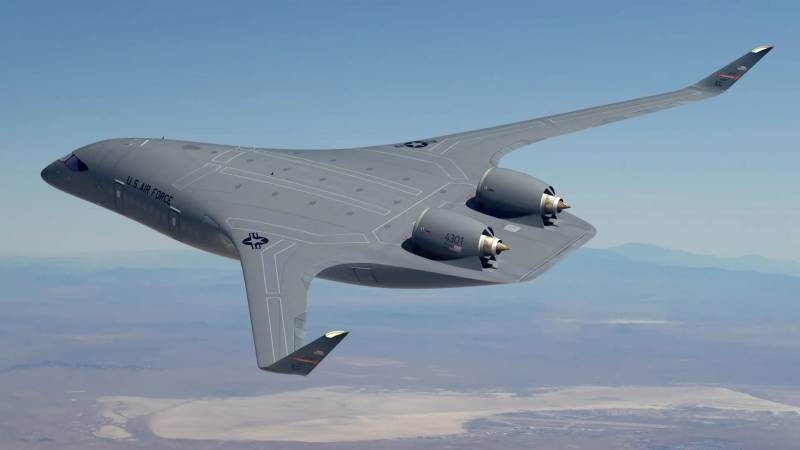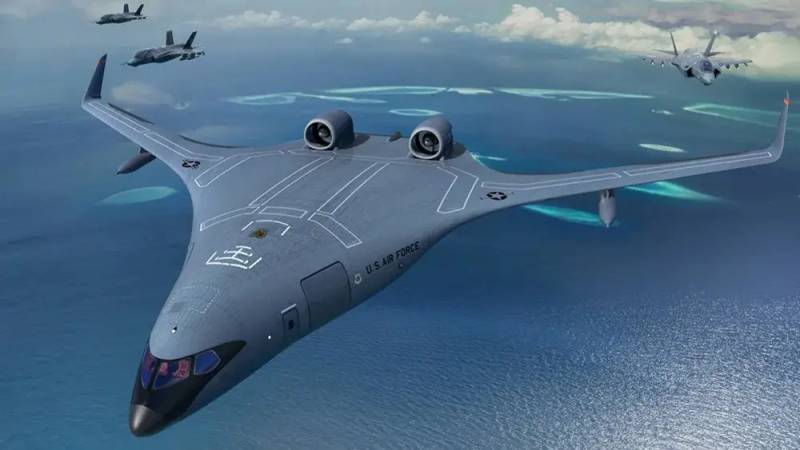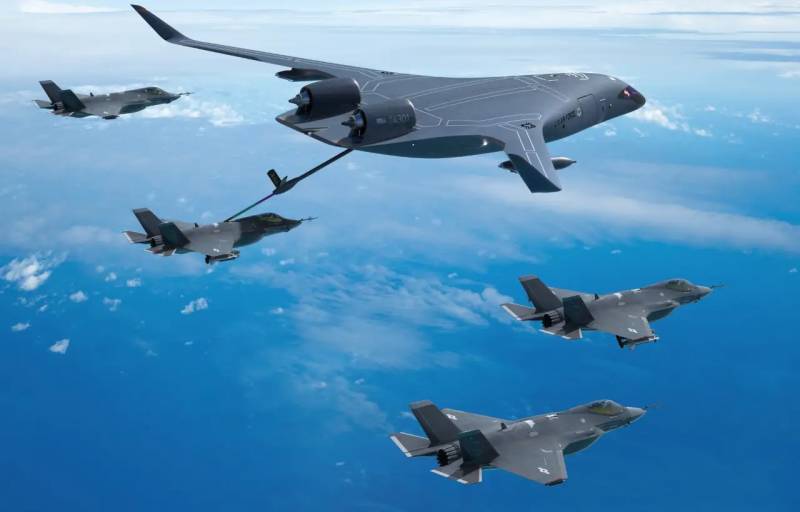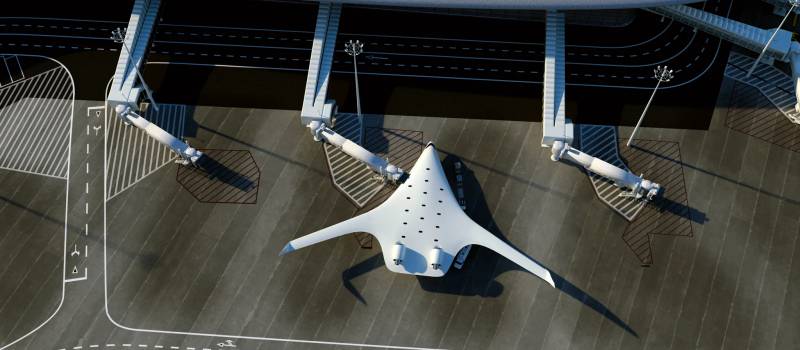US Air Force launches development of BWB aircraft

Cargo-passenger version of BWB
Last year it became known that the US Air Force is looking for new ways to develop military transport aviation and tanker aircraft. In order to improve the flight performance of such equipment, it was planned to study and work out the possibility of using the so-called. integral aerodynamic layout. To date, these works have reached the stage of developing a full-fledged project, which can be further developed.
Research work
The plans of the US Air Force to create integrated aircraft (English Blended Wing Body - BWB) were first reported by Aviation Week in early July 2022. According to him, at that time the Air Force was developing general requirements for the future program, and in the near future they were going to release so-called requesting information from the industry.
Over the next few weeks, the customer planned to collect applications from organizations wishing to participate in research and competitive development of a new project. The timing of the future research work at that time was not specified. At the same time, Aviation Week claimed that almost $57 million would be spent on this stage.
Some details of the terms of reference for BWB have been revealed. The developers were required to complete preliminary projects of a military transport aircraft with the possibility of restructuring into an air tanker. In terms of carrying capacity and flight characteristics, it should at least not be inferior to serial aircraft in service.
The BWB scheme should improve a number of key characteristics. Due to the advantages of the integrated circuit, it is necessary to increase the carrying capacity while maintaining the remaining parameters, or to increase the flight characteristics at the same load. In addition, they want to reduce operating costs, primarily fuel. The complete transition of military transport aviation and tankers to new aircraft should bring annual savings of at least $2 billion.

tanker aircraft
The promising BWB aircraft was compared with the existing Boeing 707 and other samples of this class, on the basis of which the US Air Force equipment was made. In particular, it is the "707" that is the basis for the common tanker KC-46A. Accordingly, it becomes a kind of standard in the development of a promising project.
Competition results
As is now known, a year ago the Air Force received applications for participation in the project from a number of American companies. The customer studied the proposed concepts and chose the most successful one. On August 16, Secretary of the Air Force Frank Kendall named the winner of the competitive round.
The contract for the continuation of work and the full design of the BWB aircraft was received by JetZero. She works with companies Northrop Grumman and Scaled Composites, which have extensive experience in the aviation industry. It is expected that the lead developer will form the main ideas of the project, and subcontractors will help with their implementation.
The Ministry of the Air Force called the expected time and cost of development. The customer will start paying for the design work in the next fiscal year, which starts on October 1st. The money will flow to performers until FY2027. inclusive. The development of the project, the construction of the first prototype aircraft and the conduct of the first tests are estimated at $235 million.
According to the disclosed information, the BWB project should be created using new approaches and technologies that speed up the development process. Despite the novelty of the design, the construction of an experimental aircraft should also take place in the shortest possible time. After 2025-26 it is planned to submit the aircraft for testing, and no later than 2027, the first flights will take place.

The further fate of the project will depend on the test results. If the BWB from JetZero confirms the calculated technical and operational characteristics, it will be accepted into service and mass production will be launched. However, a negative scenario is also possible with the rejection of both the current project and the very idea of introducing an integrated layout in heavy aircraft.
Concept level
Earlier, even before receiving a new contract, JetZero revealed the appearance of its version of the BWB aircraft. Several images of such an aircraft have been published in the military transport version and in the tanker configuration, incl. transferring fuel to fighters. Apparently, the final appearance of the aircraft is being demonstrated. Its fundamental changes at the current stage of the project are unlikely to suit the customer and are therefore unlikely.
The shown BWB from JetZero is a large-sized aircraft with an appropriate weight, made according to an integrated aerodynamic scheme. This scheme is similar to the well-known "flying wing", but there are noticeable differences.
The main element of the BWB airframe is the fuselage of a characteristic shape with the necessary internal volume. The streamlined nose merges into a flared midsection, behind which the wing is placed. Unlike the traditional scheme, such a fuselage is an additional plane that creates lift and complements the main wing.
Wing consoles are attached to the integral fuselage according to the high-wing scheme. Unlike the "flying wing", the interface between the fuselage and consoles is not smooth - there is a clear transition between the side of the fuselage and the plane. The consoles are swept and have a large elongation. Ends bent up are used. The aircraft has no plumage.
In the above images, the BWB has a pair of turbojet engines in nacelles on pylons above the rear fuselage. A suitable type of turbojet engine and their required parameters are not specified. Apparently, the propulsion system of the new aircraft should be similar to the Boeing 707 systems or surpass them in one way or another.

Commercial modification
By order of the Air Force, JetZero will develop two versions of the aircraft with almost complete unification. The first will be a military transport aircraft with the largest possible cargo compartment. The applied layout allows you to increase not only the total volume, but also the width of the cabin. Also, a tanker project is being worked out for the Pentagon - in this case, the useful volume of the cabin will be given for additional fuel tanks.
JetZero plans to bring its developments to the commercial market. Customers want to be interested in the concept of a passenger aircraft. Due to the special design of the fuselage, it is proposed to take on board more passengers or provide them with better conditions than in existing liners. Other benefits of various kinds are also expected.
The development company claims that its BWB will be more convenient and more economical than existing aircraft with similar characteristics. Optimized aerodynamics will reduce fuel consumption by up to 50%, making flying cheaper or increasing range. In addition, it is possible to increase the carrying capacity, which will be facilitated by a larger cabin volume. Placing the engines on top of the fuselage will reduce ground noise.
Bold plans
At the moment, JetZero's BWB project exists only in the form of some design documentation package and a few artistic images of the aircraft in flight. It takes several more years to complete the design, and then the development company, in cooperation with contractors, will have to build and test an experimental aircraft.
What will be the results of the current work is still unknown. At the same time, the development company solves important and complex tasks: the results of the project and the characteristics of the future aircraft depend on the current work. Moreover, the future of the most important components of the US Air Force fleet can now be determined. With the successful completion of the BWB program, they will be retooled and given new opportunities. However, success is not guaranteed, in which case the air fleet will not change.
Information